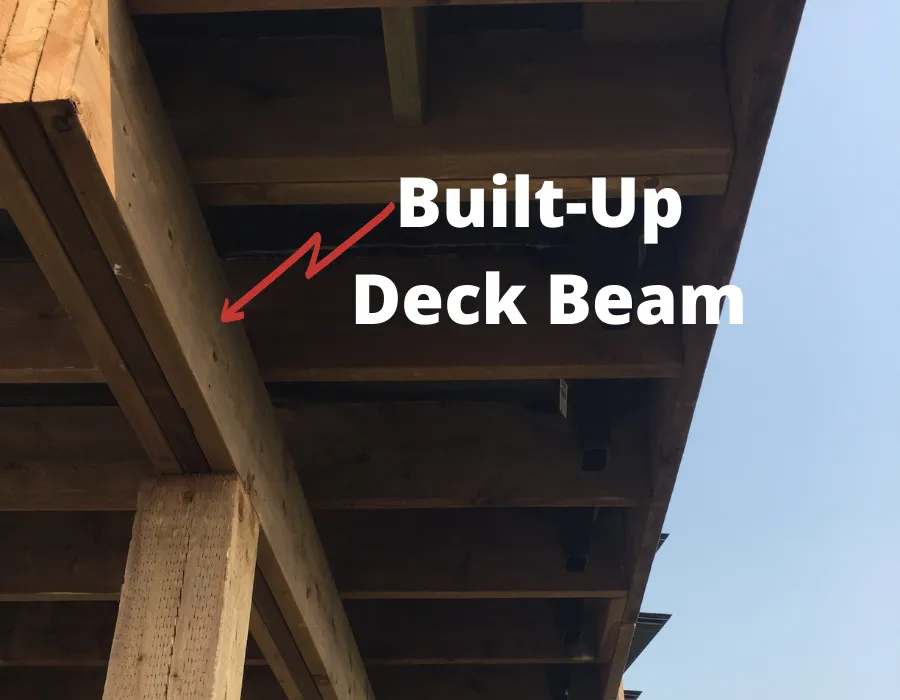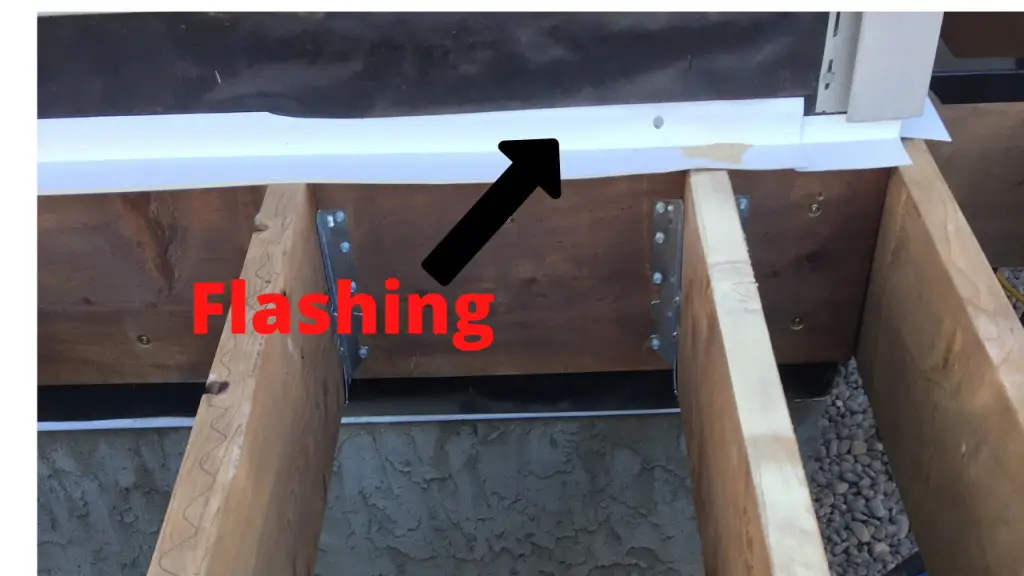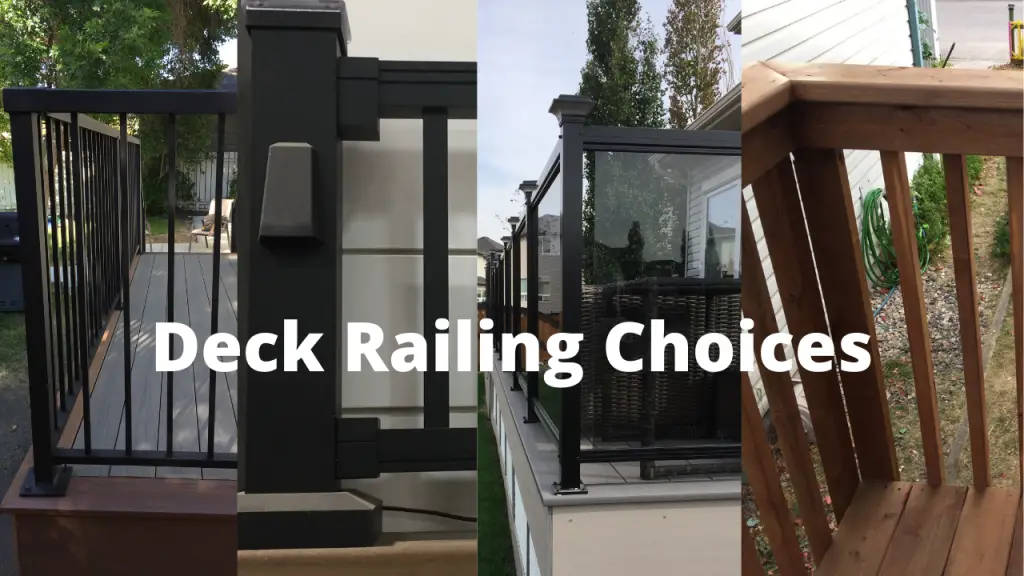A deck looks like a simple structure, but it requires a strong foundation, substructure, the right decking, railing and some designs even call for a roof or way to block the wind . To know how to build the safest deck to enjoy, make sure you know all the components of a deck.
. To know how to build the safest deck to enjoy, make sure you know all the components of a deck.
Parts of a Deck
A deck is composed of many parts. Many of which you don’t even notice but are critical to the life and enjoyment of your deck.
We will start from the bottom, deep in the ground and go through every component of a deck. Naming every part and what role it plays in your deck.
Footings
Footings help support the overall weight of your deck. They’re typically made of poured concrete, concrete blocks, buried posts, deck blocks, or helical piles. Poured concrete is the most affordable option, though you have to wait for the concrete to dry before you can build your deck.
Concrete blocks and deck blocks are easy to install and require no drying time, but they don’t provide as much permanent support compared to poured concrete. Buried posts still require concrete poured below the frost line, but it uses less concrete and allows your posts to stand tall and take center stage.
Helical piles are steel footings that screw into the ground, but you need to hire someone with hydraulic machinery to install them properly. A professional can install them in less than a day with no digging required with the right equipment. They’re the most expensive footing option, but they’re worth the investment.
*Builders note*
If your deck is attached to your house, or higher than 24″ in Canada, 30″ in the States the deck footings must be below the frost level.
Then it’s unto the frame of your deck. The frame extends from your house into the yard, representing how large you want the deck to be. It provides a structural part for everything you’ll build on top, which you’ll learn about from the bottom up.
For pictures and fuller explanations about types of deck footing , click the link.
, click the link.
Support Posts
Support posts or columns provide a vertical source of stability for the deck beams. They are usually metal or wood, but you can choose to extend the concrete footings al the way to the underside of the beam for additional permanence.
Dimensions depend on how high off the ground your deck will stand and how heavy the deck will be. The higher the deck the more significant the post needs to be.
To learn more about the size of deck post needed , click the link for full explanation.
, click the link for full explanation.
*Builders tip*
Local Code will often dictate the size and whether the post can be buried. Always check before purchasing material.
Make sure you have this information on hand when you’re selecting support posts so you can get the right height and width.
Beams
Beams, also called girders, support the joists and range anywhere from one to five boards thick. You can also choose to use solid timber if you want one-piece beams. Steel is another solid choice, though it’s more expensive than wood. Each ply needs to be fastened to the next with nails or structural screws.

To learn how to Build a Stronger Deck Beam That Won’t Rot , click the link. With three different deck beams designed to limit the amount of rot.
, click the link. With three different deck beams designed to limit the amount of rot.
Ledger
Next to the footing, this is the most critical part of your deck. It will bear the weight of the deck and determine everything else’s height.
The ledger board holds the deck framework to the wall of your house or structure. You’ll have a ledger board going across your house in the same width as the deck will be. It gives the deck’s frame and joists a solid point of contact against the sturdier structure.
Because of the importance of this part of the deck the correct fastening to the house is essential.

Flashing
Flashing is also known as a ledger cap because of how it prevents moisture from getting into your deck or home. The best materials for flashing are waterproof and resistant to corrosion, such as:
- Vinyl
- Z-shape
- L-shape
- Sheet roll
A deck’s flashing uses L or Z shaped sheets of the previously mentioned materials, though you can also buy it in rolls and shape it yourself. Its purpose is to cover the gap between the deck’s ledger board and your house. Flashing channels water away from your house to prevent structural damage.
*Builders Note*
Water behind the ledger is the number one reason for ledger failure and rot. Correctly installed flashing prevents this.
While flashing will protect your home from rot, adding a simple element to the flashing can protect your deck even better. Add deck joist flashing tape against the ledger board and on top of the joists. The tape keeps moisture from getting into your deck’s foundation as it rolls away from your house.
against the ledger board and on top of the joists. The tape keeps moisture from getting into your deck’s foundation as it rolls away from your house.
Are you trying to figure out the right type of flashing for your deck ? Click the link for a fuller explanantion.
? Click the link for a fuller explanantion.
Hardware
Hardware includes screws, fasteners, post saddles, brackets and joist hangers. These pieces are small but are just as crucial as the wood and concrete you use to build the deck. They keep everything together and choosing the right hardware will ensure your deck lasts for years.
Joists
Joists are incredibly important since they provide the structure for the floor of your deck. They run perpendicular to the ledger board, so they’ll stick out into the yard forming the length of your deck. Depending on how large your deck will be, they run from the house and ledger board over two or more deck beams.
You can use 2″ x 6″, 2″ x 8″, 2″ x10″ or 2″ x 12″ boards for your joists and space them 12″ or 16″ inches apart.
The size and spacing selected will be determined by a few factors.
- Span
- Wood used
- Decking Material
- Decking Pattern
- Railing
Plus, unique factors like deck patterns, herringbone for example. Which you’ll need specific joist spacing to create the pattern. Make sure you know those details before installing joists.
The rim joist runs perpendicular to the other joists, across their open ends. It closes those openings and maintains the distance between joists. Rim joists prevent the joists from moving while you continue to build on them and provide support for railing posts and stairs in later steps.
Bridging
Bridging, also called blocking, refers to the small blocks of wood that you install between the joists. They keep the joists in place, so they don’t move or migrate across the deck as people walk around on the surface.
Bridging will also increase the strength of the joists by joining them all together to strengthen each other. The blocking will also straighten out the joists, increasing strength and improving appearance.
Once your joists are in place, you want to add bridging every four to six feet or thirds of the length of the joists for optimal stability. They should be the same height as joists, and you should align and level the top of the joists and bridging.
Blocking
Beyond bridging, there are many other locations in which blocking will increase strength, support material or improve the deck’s performance.
Under top-mounted railing posts, picture framing are just two of many locations to consider installing deck blocking.
To learn more uses and tips about deck blocking , click the link.
, click the link.
Decking
Decking is the floor of your deck. There are many different materials to choose from, which opens you up to various colours and sizes. As previously mentioned, you can create a pattern with your decking as long as the joists can support it.
Some popular decking materials are.
- Pressure-treated
- Cedar
- Composite
- PVC
- Tropical hardwood like Ipe
When selecting decking, you want to think about what type of weather you get. It’s best to choose a material that won’t rot or wear in your location’s typical climate. You can protect wood using sealant and stain. Synthetics like composite and PVC decking boards will last much longer and require less maintenance.

The type of decking material  will affect the cost of the deck, with longer-lasting, lower maintenance decking often costing more initially than cheaper but more upkeep options like treated wood or cedar.
will affect the cost of the deck, with longer-lasting, lower maintenance decking often costing more initially than cheaper but more upkeep options like treated wood or cedar.
Workability needs to also be considered. Ipe is one of the most durable wood deckings but requires a higher level skill set to correctly install.
Beyond these, you can even select aluminum or vinyl materials to give your deck a unique look and long-lasting durability. These surfaces are easier to clean than wood and won’t fade in the sun or rot in wet climates.
Railing
The right railing is crucial for your deck design because it prevents trips and falls. Railings must be strong enough to handle 200 pounds of force pushing or pulling against them. Some cities have different requirements. When you’re getting information about your building permit , make sure you find out about railing weight limits as well.
, make sure you find out about railing weight limits as well.
The height of the railing is also important for deck safety. Ground-level decks often do not require a railing. Taller decks will require a minimum of 36″ railing height. Decks higher than 6′ will require an even taller railing of 42″. But check your local code to know for sure.

Besides providing safety, railings also add decorative elements to your deck. You can make them from wood, glass, metal, vinyl, cable, or rope, depending on your house’s overall aesthetic and how you want the deck to look.
For a more in-depth look at different types of deck railing , click the link.
, click the link.
Railing includes the top rail, also called the handrail. This is the uppermost piece of railing that runs horizontal to any vertical railing spindles or slats. The top rail is usually a bit wider than the railing to provide more of a grip for people walking around. A handrail needs to be between 34″ and 38″ above the deck’s surface so people can comfortably hold it.
The base rail runs parallel to the handrail at the bottom of the railing. It provides support for the spindles or slats and keeps them evenly spaced. The base rail must be no higher than 4″ from the deck’s surface.
Spindles or slats are the vertical parts of the railing that create a barrier or guard between the deck’s living area and the outside space. You can find carved or uniquely shaped spindles to give your deck a certain look or use plain boards for a basic structure.
Railing Posts
Railing posts anchor each of the railing components to the deck. They’re usually solid timbers, either 4″ x 4″ or 6″ x 6″ for the most stability. They have to withstand a strong force pushing and pulling against the railing, so they’re bolted to end joists.
Or in the case of aluminum railing the post will be screwed to blocking attached to the joist below the decking. Aluminum has the advantage of increasing strength with a small, less intrusive size.
Stairs
Stairs give you a way to step from the deck down into your yard. Some builders have decks of different elevations built into one, so stairs might also help you get into the house and between various levels.
Deck stairs are composed of stringers, treads, and riser boards. Stringers are vertical support boards found either on the sides or in the center of the stairs. Treads are the boards you step on, so you want something sturdy and attractive.
Riser boards are the vertical boards holding the treads in place. They look great stained the same colour as the treads, but complementary and contrasting looks add a unique look to your deck.
Commonly stairs will have an individual rise of 7″ but can be as little as 6″ or as great as 8″ depending on the height between the two surfaces. Consistency between steps is required.
Treads often are composed of two parrel deck boards. Creating a step of roughly 11″.
Stringer can either be custom cut to your exact deck requirement or bought from your local building supply store, precut. Saving you time.
Conclusion
With an understanding of all the parts of a deck, you’re ready to design and build your outdoor oasis. These parts give you the basic foundation, but you can always further level up this space with a roof for weather protection, walls for privacy, and lighting so the nights never have to end. A deck might seem like a simple structure, but there are countless ways to make it unique to best suit your property’s aesthetic and DIY sensibility.
so the nights never have to end. A deck might seem like a simple structure, but there are countless ways to make it unique to best suit your property’s aesthetic and DIY sensibility.
